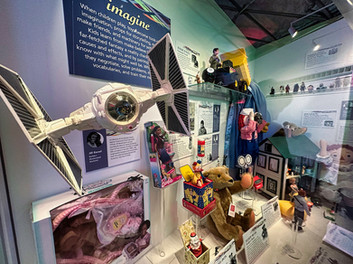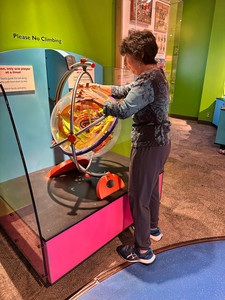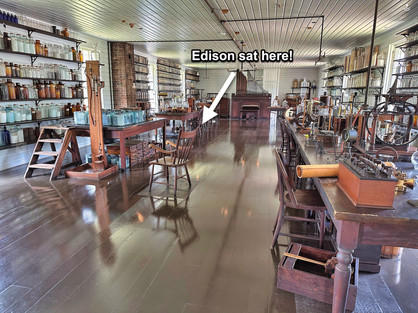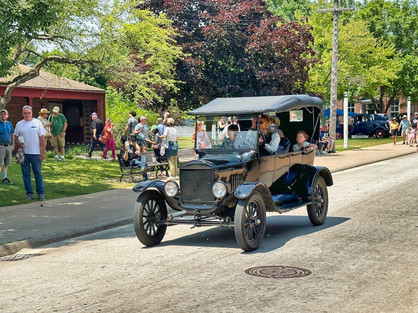
Leaving our Virginia home on June 8 (where the air quality was Code Purple due to the Canadian wildfires), we traveled north (toward the wildfires) embarking on our three-month circuit of the Great Lakes. Fortunately for us, the air cleared bit by bit as we drove, and was quite fresh by the time we reached our first Great Lake the next afternoon.

The first night we overnighted at Ives Run, a Corps of Engineers reservoir near the Pennsylvania/New York border, and continued the next day to Webster, NY, setting up at a county campground on the southern banks of Lake Ontario.

Doug was recovering from a cold, so he rested while Jeannette busied herself with small Ciaowagen improvement projects and a thorough cleaning of the interior which was gritty with smoke residue. However, we did want to explore the area a bit, and Webster is very close to Rochester, NY. We spent an afternoon at the Strong National Museum of Play, a quite large and interesting museum dedicated to all forms of play, including toys, dolls, and games (manual, electronic, and video).

We departed Webster and drove west on I-90, first along the bottom of Lake Ontario and then, after passing Buffalo, NY, along the bottom of Lake Erie, through Pennsylvania, and finally settling in outside Cleveland, OH. During our stay, an gastric virus kept Doug down for a day. A visit to an urgent care yielded some meds to help solve the problem.
One day, we headed to downtown Cleveland for a visit to the Rock and Roll Hall of Fame on the Lake Erie waterfront.

We’d been to the Hall of Fame in 2002 during our first RV adventure with our kids.

It hadn’t changed all that much, except there are now many more inductees.

There was a karaoke area (we declined)...

…and many artifacts such as clothing…

…instruments...
… and even The Wall concert stage from Pink Floyd.

There was also an excellent temporary exhibit about the Beatles.
The next day, we got our first hiking in with a visit to Cuyahoga Falls National Park, which we’d visited on our cross-country trek at the start of our 2021 Alaska trip. We hiked a three-mile loop trail that ended at 70-foot-high Brandywine Falls.


It was time to move on, and we traveled to the Detroit, MI area, staying in a KOA campground between Detroit and Ann Arbor. It was Father’s Day weekend, and the campground was packed with families. Lots of kids riding bikes, people playing in the lake, and karaoke late into the evening made for a noisy environment. We met people who were at the start of a twenty-two strong caravan (RV-avan?) that would spend a month exploring the lower and upper peninsulas of Michigan.
We drove the Fittata to Dearborn, MI (south of Detroit city) and spent the day at The Henry Ford museum complex. Most of the area is take up by Greenfield Village, Henry Ford’s historical theme park, similar to Williamsburg.

Ford relocated a number of historical buildings, including the Wright Brothers’ Dayton, OH bicycle shop, where they built the first Wright Flyer in a shed at the back of the shop. He’d relocated the Wright family home to be next to it.

Ford also relocated Thomas Edison’s lab from Menlo Park, NJ, including furniture, lab supplies, machines, even a chair where Thomas Edison sat during a celebration at Greenfield Village of the 50th anniversary of the invention of the lightbulb (and which Henry Ford insisted be nailed in place to the floor so it would remain there in perpetuity).
Unbeknownst to us, the day we’d picked for our visit coincided with Greenfield Village’s annual car rally. We spent several hours wandering among vehicles from the 1930s to the 1980s, many restored and driven by hobbyists from around Michigan.
We moved on to the Henry Ford Museum of Innovation, where they had also collected artifacts such as Edgar Allen Poe's writing desk and an original Oscar Meyer Wienermobile.
In the museum they also had the only surviving example of a Dymaxion House, designed by Buckminster Fuller after World War II as a way of providing affordable housing for veterans. Built from aluminum and plexiglass, the house would be hung from a central stainless steel column, shipped in two containers, and could be assembled in two days.


Fuller also envisioned this house as a way to keep employment going in the aircraft factories after the end of the war. Unfortunately, due to disputes with his investors, the Dymaxion Company went out of business and never built any houses. Fuller moved on... to the geodesic dome.
The next day, we returned to Dearborn in the afternoon for a tour of the Ford Rouge Assembly Plant (named for the local Rouge River), built by the Ford Company in the 1920s and still being used today. After watching two movies (one about the plant and the other about the modern F150 truck assembly line), we toured above the factory floor where Ford F-150 trucks were being built. It was really interesting to watch both robotic and manual assembly steps taking place as the trucks moved slowly along the line. Bodies were built on one line, and pickup beds on another, and then matched up – computers ensuring that the colors matched correctly!
Overhead, there was a maze of rails from which were suspended car parts, dashboards and steering wheel assemblies, doors, cab, all sequenced by computers to make sure the correct pieces matched the particular car being assembled. The tour ended at the massive quality control complex where final testing was done - each car being run at 70 mph (on treadmills), alignment checked, undercarriage being personally inspected and photographed, before being driven to the storage lot. Unfortunately, due to both Ford and UAW rules, we were not allowed to take any pictures during the tour.
Jeannette tried to see if there were any “factory seconds” available, since tours often include freebies. The only ones she spied was a group of cars bearing the tag “Reverse Gear Missing.” She wisely decided not to pursue the idea further
Our last full day in the area, we traveled to Ann Arbor. We took a long hike through the University of Michigan’s arboretum. One of the highlights was a peony garden with hundreds of varieties on display.

We also visited the University’s Natural History Museum.

Before leaving Ann Arbor, we walked down the main street with shops, restaurants, bookstores, and everything else you find in a typical college town.
Having bagged three Great lakes cities, it was time for the next phase of our trip, touring counterclockwise around the “mitten” of Lower Michigan (yes, the lower part of Michigan is shaped like a mitten). More about those travels in our next blog post!













































Comments